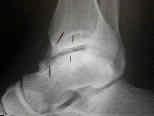- Bony Impingement:
- pts who have persistent pain in anterior aspect of ankle & who have anterior tibiotalar spur evident on a lateral roentgenogram need additional diagnostic evaluation and management;
- extreme dorsiflexion required by the demiplie position in ballet can lead to impingement of anterior lip of tibia on talar neck;
- natural sulcus is present on superior aspect of talar neck & accomodates anterior tibial ridge in most ordinary circumstances of dorsiflexion;
- however, w/ hyperdorsiflexion in ballet dancing can produce direct contact between the tibia and the talus;
- w/ repeated impingement, exostoses form, providing basis for anterior impingement syndrome;
- Soft Tissue Impingement:
- may arise from ankle sprains, but physical exam may fail to show instability;
- may occur along the anterolateral portion of the ankle just above the ATFL;
- radiographs may be unremarkable;
- diff dx:
- equinus contracture
- Exam:
- tenderness is present between anterior tibial tendon & medial malleolus;
- tenderness accentuated with dorsiflexion and relieved w/ plantar flex;
- w/ ankle in plantar flexion, exostoses can be palpated on superior surface of the talar neck;
- tenderness is present on the anterolateral aspect of the ankle joint;
- Radiographs:
- lateral x-ray demonstrates hyperdorsiflexion contact of the anterior lip on talar neck;
- lateral dorsiflexion-stress roentgenogram may also show abutment between anterior tibial spur and the talus;
- consider radiographs of the opposite foot to determine the angle between the talus and calcaneus;
- Non Operative Treatment:
- as both a diagnostic and therapeutic measure, single intra-articular injection of long-acting anesthetic, w/ or w/o use of cortisone, combined with a felt one-centimeter heel-lift can sometimes eliminate all painful symptoms;
- Treatment:
- arthroscopic or open resection of spur may be considered (see: ankle arthroscopy);
- w/ large spurs consider open arthrotomy over arthroscopic excision;
- w/ arthroscopic technique, do not use distraction of the joint because it results in tightening of the anterior capsule, which makes it more difficult to identify the osteophytes;
- spurs are identified when the ankle is in a fully dorsiflexed position (dorsiflexion also helps avoid iatrogenic injury to the talus);
- operative radiographs should be compared to preopeartive radiographs;
- Outcomes:
- in the report by van Dijk CN, et al (1997)
- 62 consecutive patients with painful limited dorsiflexion of the ankle not responding to nonoperative treatment participated in a prospective study;
- all underwent arthroscopic surgery;
- preoperative radiographs were graded according to an osteoarthritic and an impingement classification;
- results showed that the degree of osteoarthritic changes is a better prognostic factor for the outcome of arthroscopic surgery for anterior ankle impingement than size and location of the spurs;
- hypothesis is that osteophytes without joint space narrowing are not a manifestation of osteoarthritic changes but rather the result of local (micro)trauma;
- after 2 years, 73% of the patients experienced overall excellent or good results; 90% of those without joint space narrowing had good or excellent results;
- 50% of those with joint space narrowing had good or excellent results.
- at the 2-year followup, the group without joint space narrowing showed significantly better scores in pain, swelling, ability to work, and engagement in sports;
- history of anterior ankle pain of less than 2 years and an anteromedial impingement (as opposed to an anterolateral) resulted in superior patient satisfaction;
- in the report by Tol JL, et al, the authors performed a prospective study to assess the long-term outcome of 57 arthroscopic debridement procedures carried out to treat anterior impingement in the ankle;
- using preoperative radiographs, we grouped patients according to the extent of their osteoarthritis (OA);
- symptoms of those with grade-0 changes could be attributed to anterior soft-tissue impingement alone;
- patients with grade-I disease had both anterior soft-tissue and osteophytic impingement, but no narrowing of the joint space;
- in those with grade-II OA, narrowing of the joint space was accompanied by osteophytic impingement;
- radiographs taken before and after operation and at follow-up were compared to assess the recurrence of osteophytes and the progression of narrowing of the joint space;
- at a mean follow-up of 6.5 years (5 to 8) all patients without OA had excellent or good results;
- there were excellent or good results in 77% of patients with grade-I OA, despite partial or complete recurrence of osteophytes in two-thirds;
- in most patients with grade-II OA, narrowing of the joint space had not progressed at follow-up;
- there was a notable improvement in pain in these patients, 53% of whom had excellent or good results;
- although some osteophytes recurred, at long-term follow-up arthroscopic excision of soft-tissue overgrowths and osteophytes proved to be an effective way of treating anterior impingement of the ankle in patients who had no narrowing of the joint space;
- refs: A prospective study of prognostic factors concerning the outcome of arthroscopic surgery for anterior ankle impingement.
Arthroscopic treatment of anterior impingement in the ankle.
Talar impingement by the anteroinferior tibiofibular ligament. A cause of chronic pain in the ankle after inversion sprain.
Arthroscopic treatment of synovial impingement of the ankle.
Arthroscopic treatment of anterolateral ankle impingement.
Meniscoid lesions of the ankle.
A prospective study of prognostic factors concerning the outcome of arthroscopic surgery for anterior ankle impingement.
Open treatment of anterior impingement of the ankle.
The anterior ankle impingement syndrome: diagnostic value of oblique radiographs.


